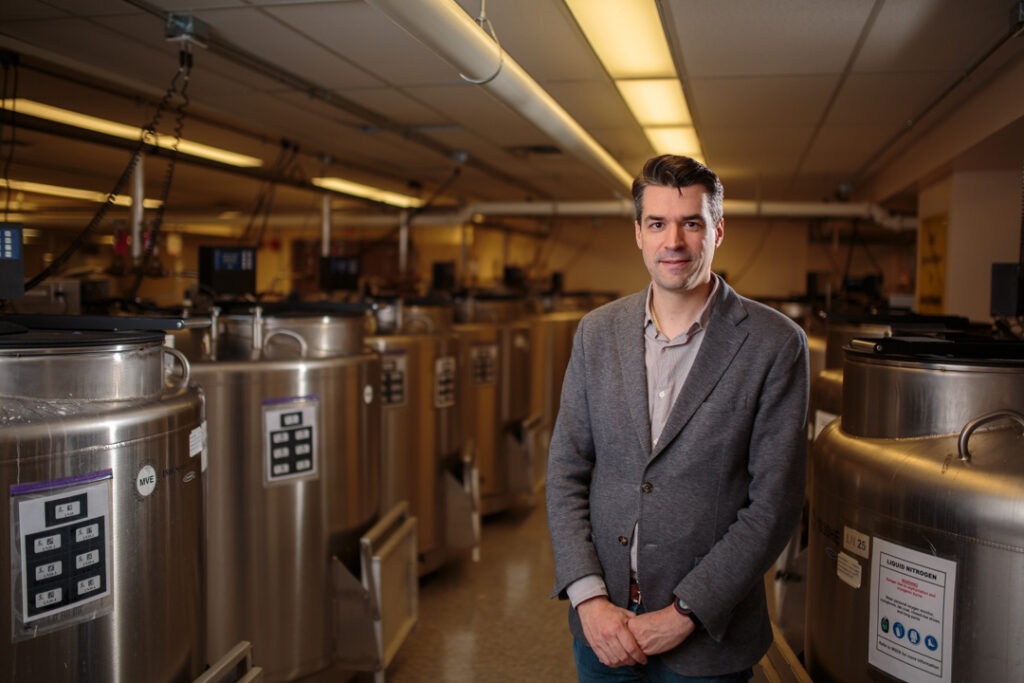
Predicting risk of disease decades in advance
Imagine a world where genetic testing is routinely used to screen for risk of late-onset diseases — like coronary artery disease (CAD), diabetes and many cancers – and intervention happens decades in advance so that people never go on to develop those illnesses.
“This would be an incredibly powerful tool in disease prevention, given that genetics determines the risk of late-onset diseases to a large extent,” says Dr. Guillaume Paré, a medical biochemist at Hamilton Health Sciences (HHS); senior scientist with the Population Health Research Institute (PHRI), a joint institute of HHS and McMaster University; and deputy director of the Thrombosis and Atherosclerosis Research Institute of McMaster and HHS.
Paré and his PHRI team are helping to make this future possible by expanding their award-winning research using technology called polygenic (multi-gene) risk scores to predict early signs of coronary artery disease (CAD) in young adults, into other diseases.
“While my own area of interest is cardiovascular disease, this type of technology is applicable to almost every disease,” says Paré, who is passionate about disease prevention.
“This would be an incredibly powerful tool in disease prevention.”
Paré, was one of four researchers honoured at the 2023 Hamilton Health Sciences Foundation Gala last month celebrating research and innovation at HHS. Each of the recipients — which also included Drs. Peter Gross, Jason Roberts and Mark Tarnopolsky — received a $40,000 grant to take their innovative commercialization research projects to the next level.
Expanding award-winning research
In 2018, Paré’s study on early CAD was named one of the year’s top 10 most influential advancements in heart and stroke research by the American Heart Association. The recognition was for a genetic test developed by Paré and his team using polygenic risk scores. It proved to be five times more accurate than the current standard method in predicting early CAD in younger adults.
“This research can also be used to detect signs of other diseases years in advance, and intervene so they never develop,” says Paré, whose current study supported by the Foundation grant aims to broaden and improve using polygenic risk scores for additional diseases, and adapt them to recent advances in genome sequencing to increase accuracy. He also hopes to expand this work internationally.
Creative solutions
With Paré’s earlier research, the challenge his team faced was that many patients with early-onset heart disease do not have the single genetic defect measured by standard testing. The team believed that the rare gene mutation couldn’t be the only way that someone becomes susceptible to CAD, and through their research found that there are actually several thousand genetic differences which, combined, can significantly increase a person’s risk, even more than the single gene mutation.
“I can even see a future where young adults undergo genetic testing as part of their routine medical care.”
“This research was born out of frustration from seeing patients at HHS’ Hamilton General Hospital with very early CAD, who had a family history yet we couldn’t identify any known genetic cause through the standard testing methods,” says Paré. “We felt that there had to be other ways to investigate this, and decided to apply polygenic risk scores to assess risk of this disease.”
Paré and his team compared polygenic risk scores between study participants with and without early-onset heart disease. They found that the polygenic risk score predicted 23 per cent of cases of early-onset heart disease, compared to three per cent for the single genetic test. Additionally, none of the patients with high polygenic risk scores had the rare genetic defect for familial hypercholesterolemia – a genetic disorder that increases the likelihood of having CAD at a younger age –meaning the current testing method would not have identified them as at-risk for early CAD.
Closing the gap
While major advancements are happening behind the lab doors, Paré looks forward to the day when patients in Canada and around the world will benefit from this research as part of their routine medical care.
“The field of genetics has progressed far beyond what’s currently being done in clinical practice,” he says. “It’s a gap we need to bridge because there’s enormous potential for disease prevention and early intervention. I can even see a future where young adults undergo genetic testing as part of their routine medical care and a risk profile is established for the most common late-onset diseases.”



